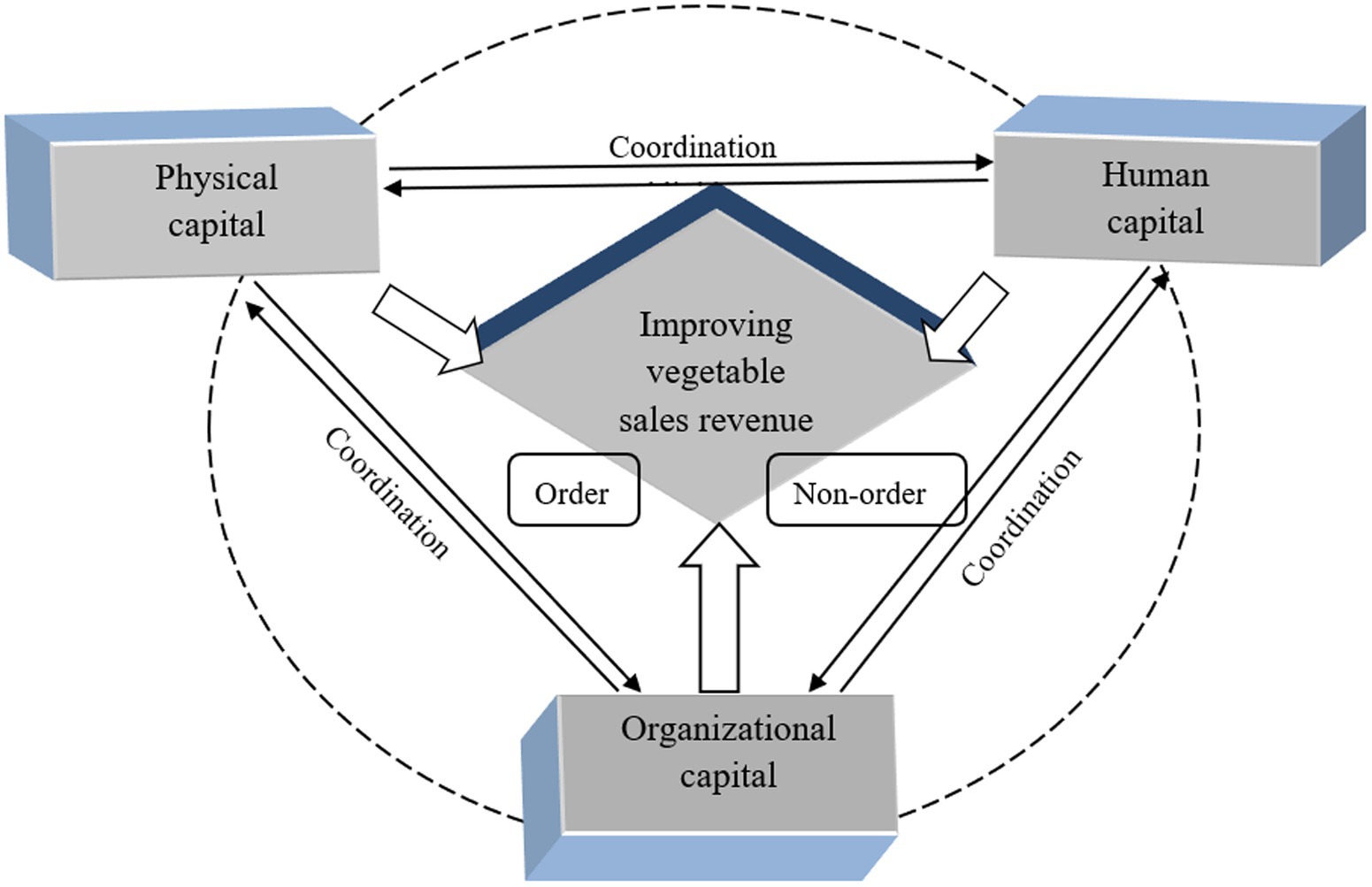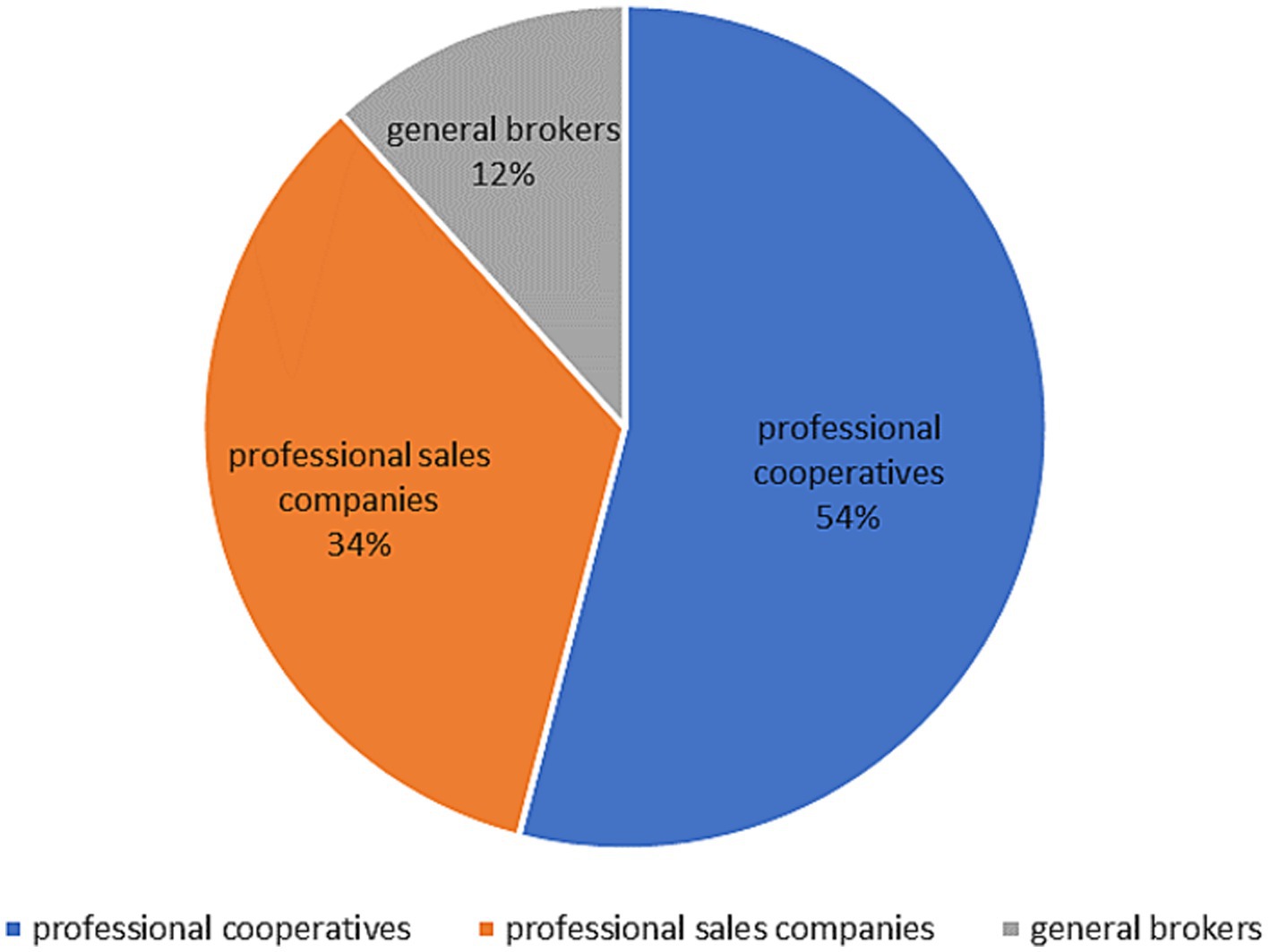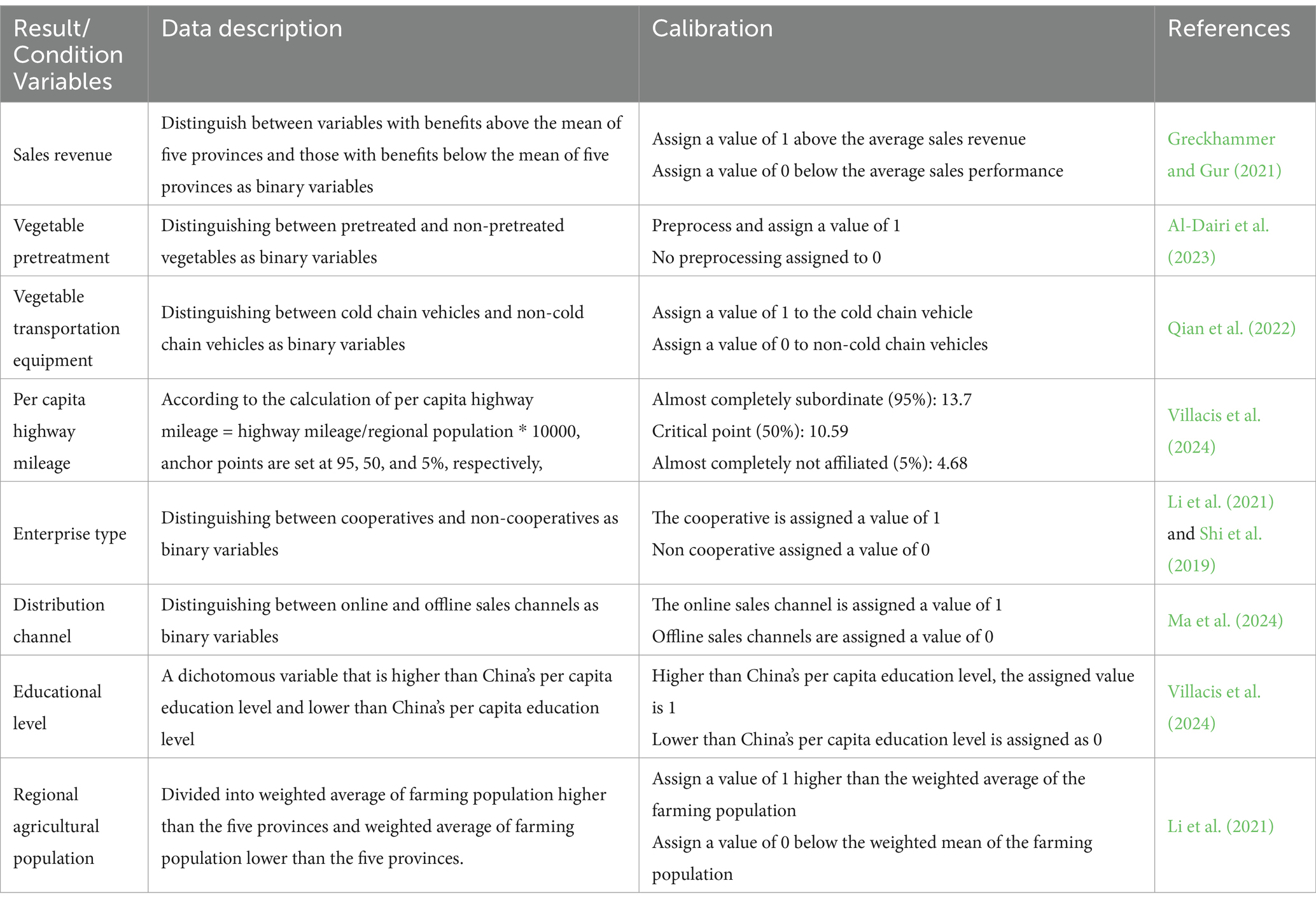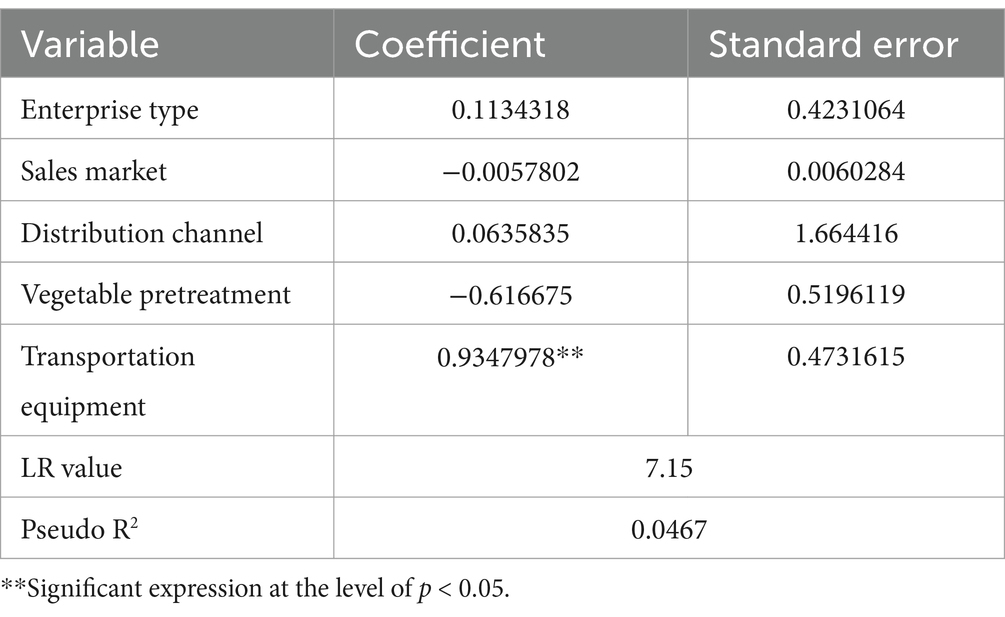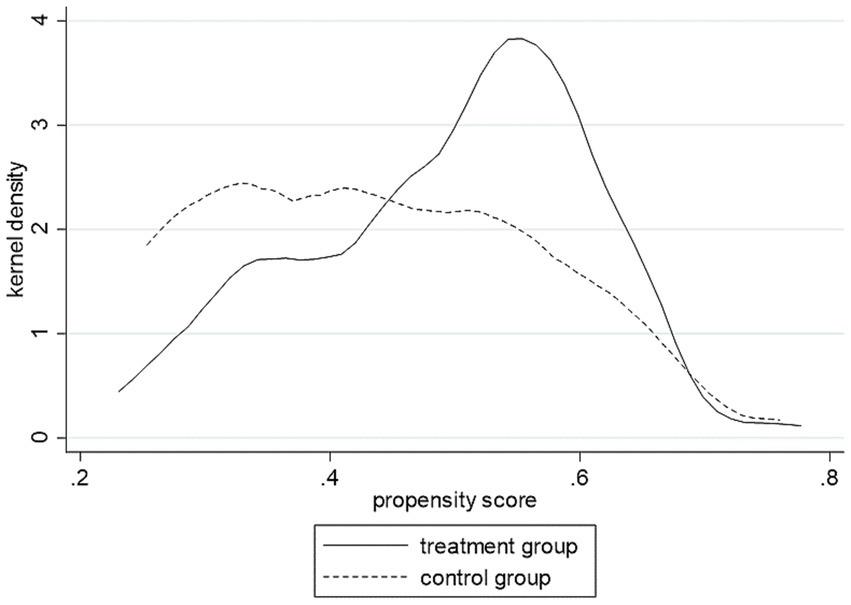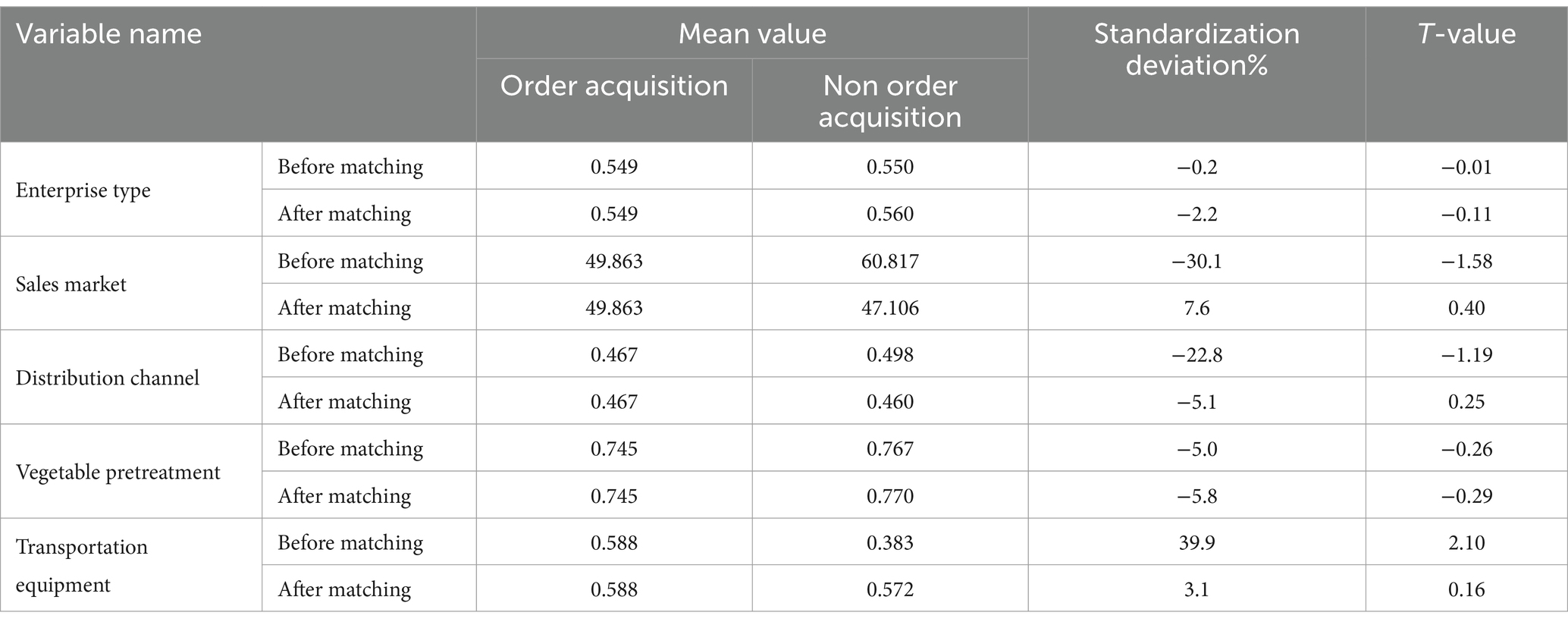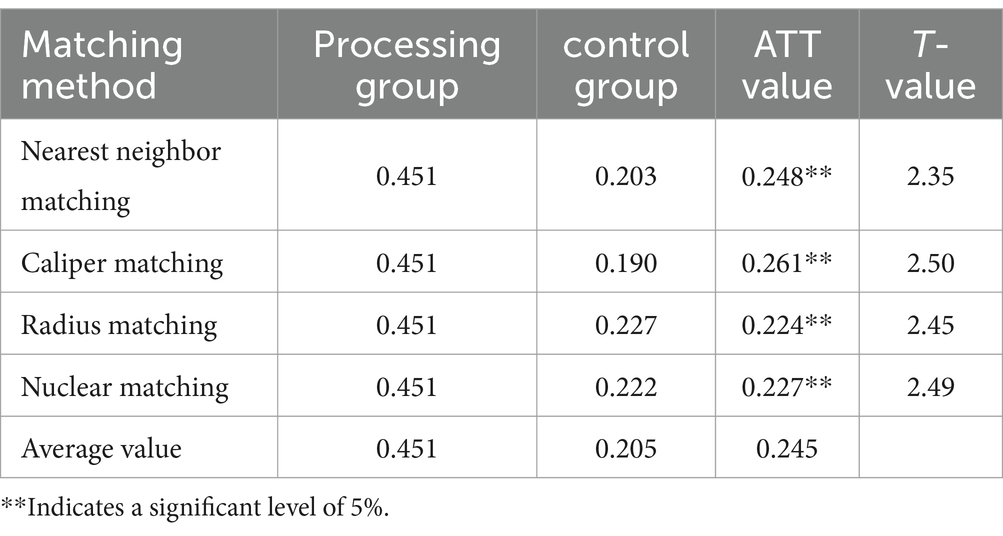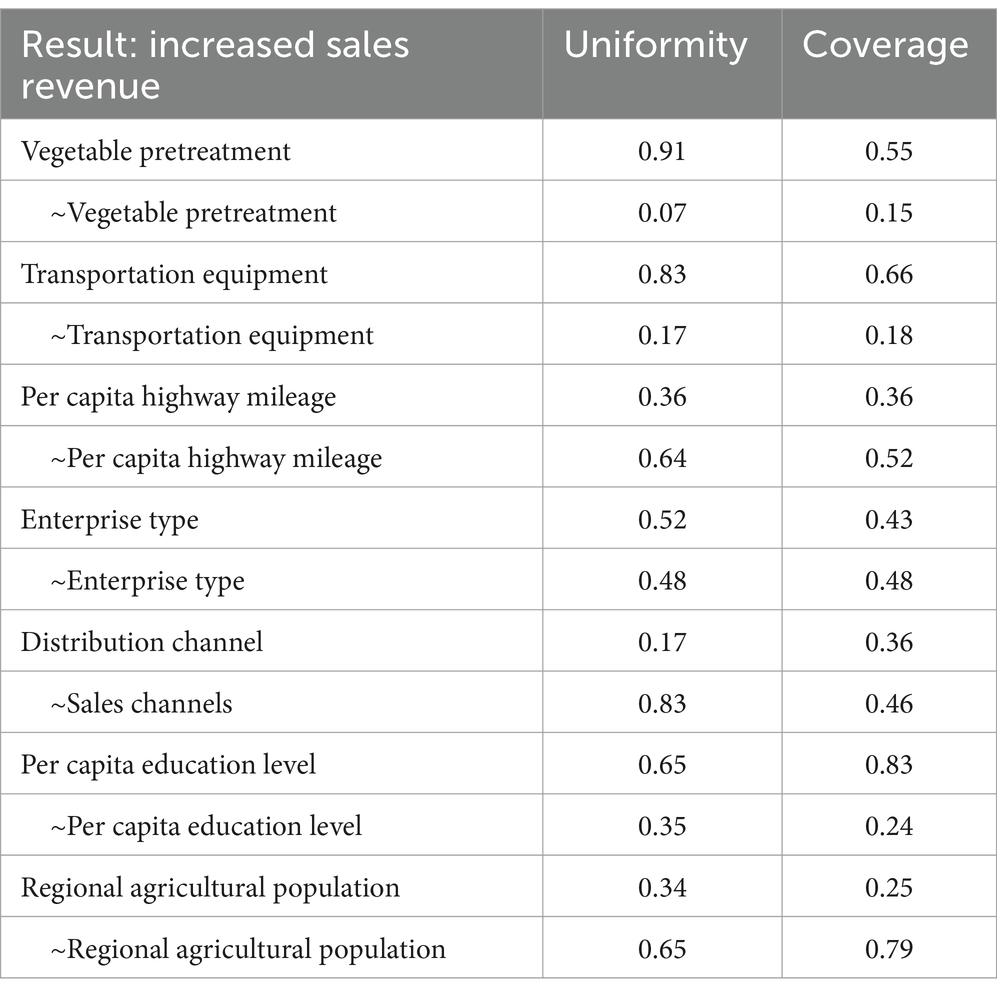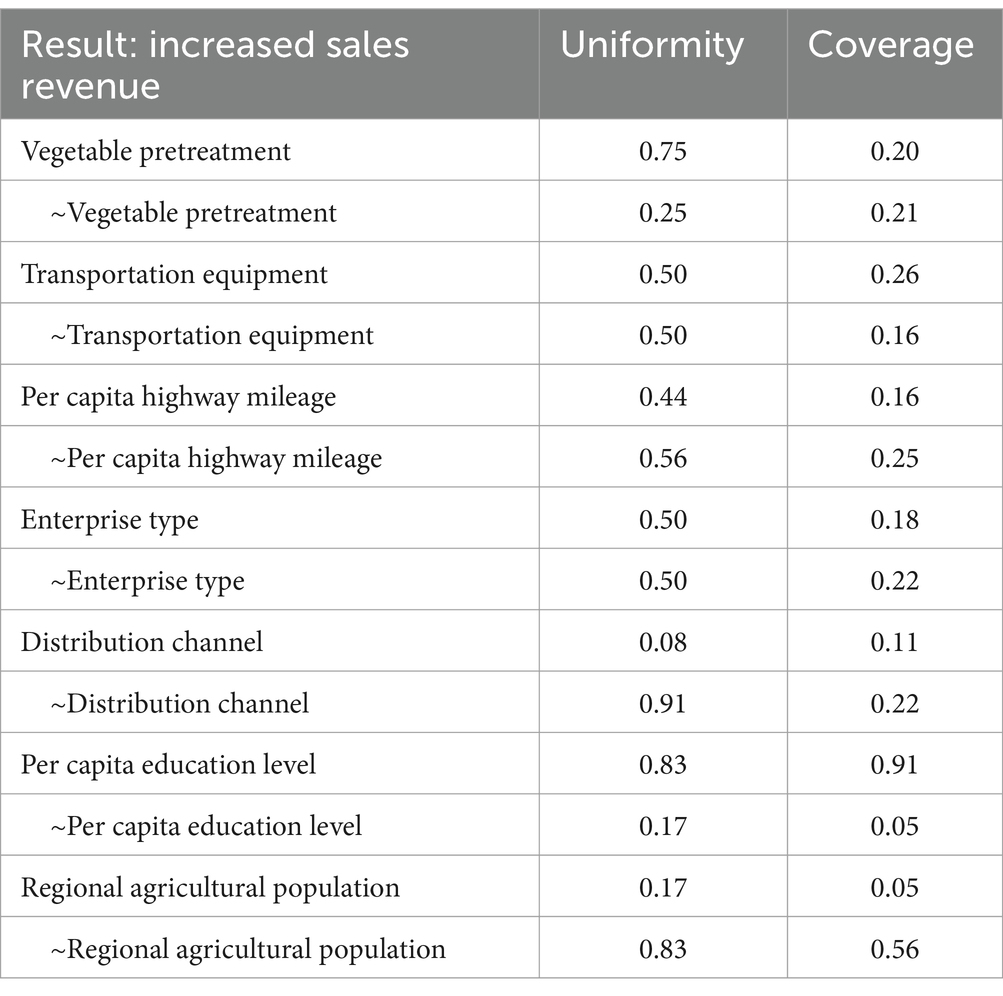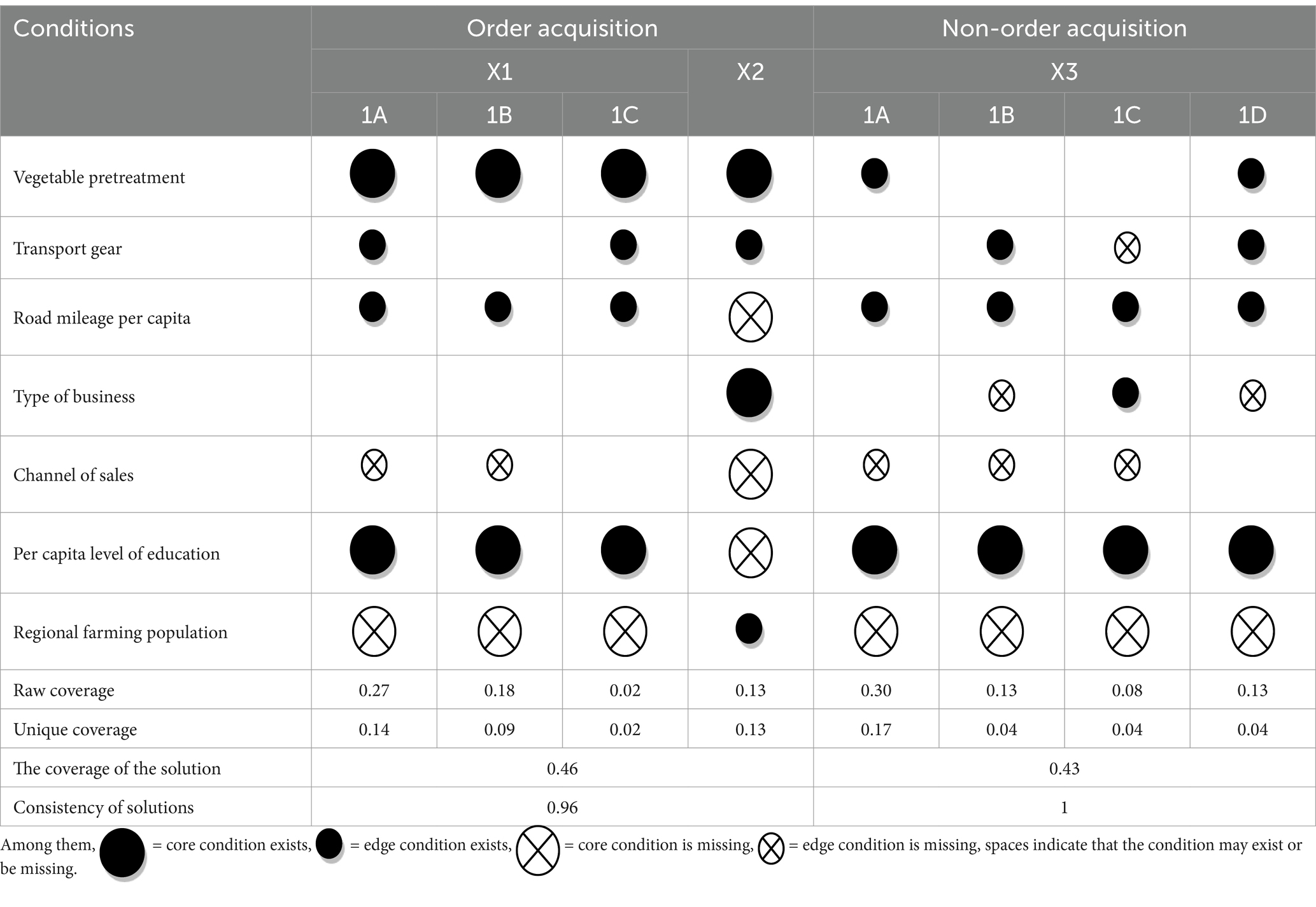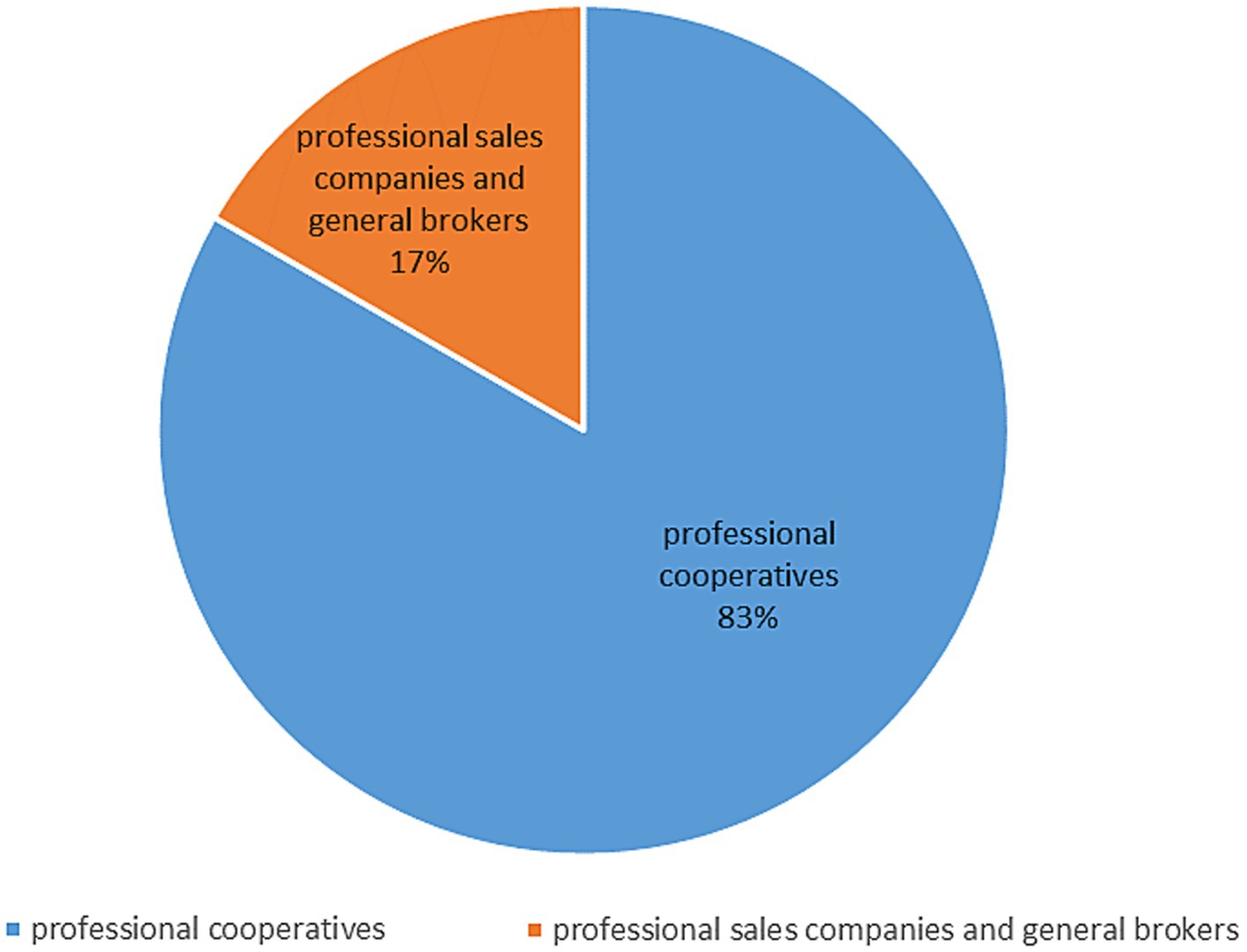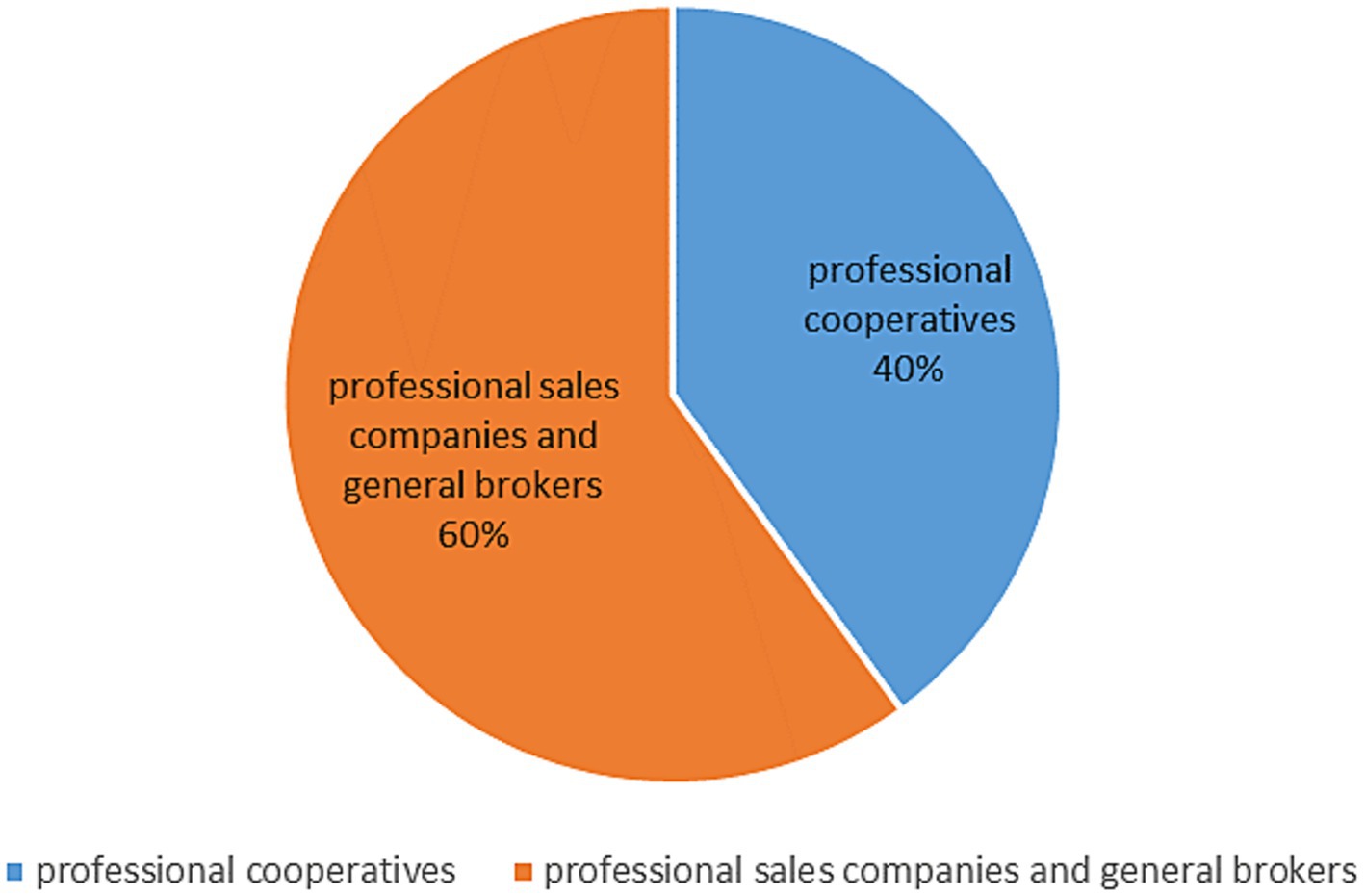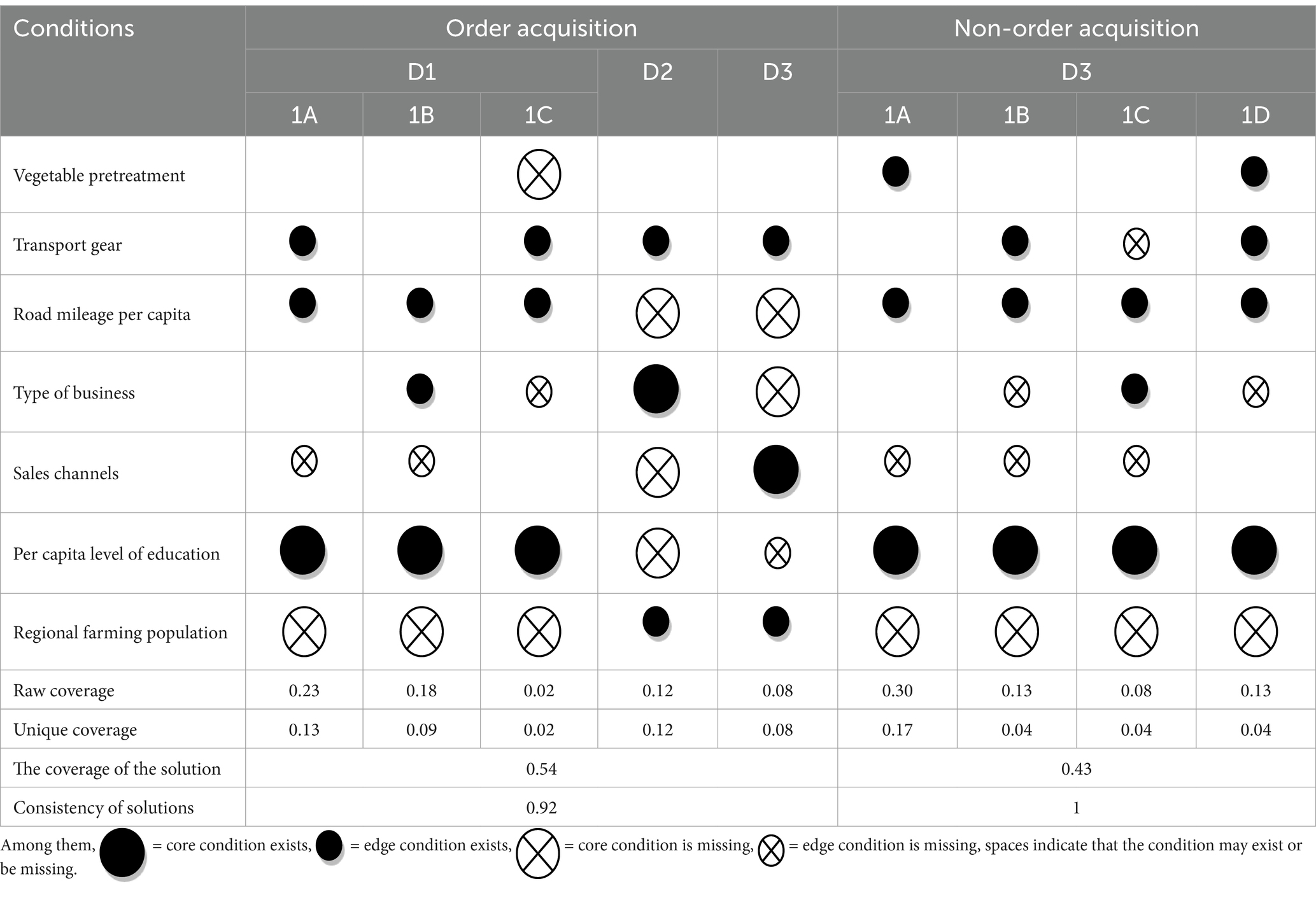- 1Hunan Agricultural University, Business School, Changsha, China
- 2Institute of Agricultural Economics and Development, CAAS, Beijing, China
- 3Changsha University of Science and Technology, School of Economics and Management, Changsha, China
Introduction: The sales revenue of agricultural products is pivotal for augmenting farmer income and fostering sustainable agricultural economic development.
Methods: This study employs propensity score matching (PSM) and establishes a structural analytical framework grounded in the Resource-Based View (RBV) to mitigate endogeneity concerns. Fuzzy-set qualitative comparative analysis (fsQCA) is applied to examine survey data from 111 vegetable distribution firms, exploring pathways for enhancing sales revenue under two distinct acquisition models.
Results: The findings reveal that: (1) fsQCA empirical analyses demonstrate that physical, human, and organizational capital collectively contribute to revenue enhancement. (2) Under the contract farming model, both physical and human capital emerge as core drivers of sales revenue, whereas non-contract farming configurations are predominantly characterized by human capital as the central determinant. (3) While both models emphasize human capital, the contract farming framework further underscores the integral role of physical capital across the entire value chain.
Discussion: This study integrates the Resource-Based View (RBV) with fuzzy-set Qualitative Comparative Analysis (fsQCA) to uncover the synergistic effects of three types of capital (physical, human, and organizational) on vegetable sales revenue, thereby overcoming the limitations of traditional research that focuses narrowly on single production factors. Furthermore, it constructs a multi-dimensional theoretical framework and proposes differentiated resource-driven mechanisms, which helps policy makers to optimize various conditions in a targeted manner and promote the improvement of farm products sales revenue.
1 Introduction
Vegetables, as a staple agricultural commodity in residents’ daily dietary intake, critically influence both the economic livelihoods of vegetable farmers and the sustainable, stable development of rural economies. This study investigates the vegetable cultivation systems in alpine and plateau regions. Alpine and plateau vegetables are defined as commercially cultivated off-season crops grown by exploiting the natural cold climatic conditions of high-altitude zones during summer. Key varieties encompass alpine vegetables from the central Yangtze River Basin, cold-tolerant crops in the northern Bashang and Loess Plateau, and summer-autumn cultivars in the western Yungui region. Alpine and plateau vegetable production has significantly contributed to stabilizing China’s summer-autumn vegetable supply, elevating incomes in mountainous communities, and advancing ecologically sustainable agricultural practices. Municipal and county-level data indicate that alpine vegetable production in Chongqing generates an output value of 9,800 yuan per mu. In geographically isolated counties and villages with limited transportation access, localized vegetable sales yield net incomes exceeding 5,000 yuan. In Gansu Province, Yuzhong County’s alpine vegetable production reached 898,000 tons by 2023, directly benefiting over 60,000 households through an average income uplift of 20,000 yuan. Nevertheless, China’s alpine and plateau vegetable production systems are predominantly located in remote mountainous territories characterized by underdeveloped infrastructure, transportation constraints, and elevated poverty levels, despite vegetable cultivation remaining a primary income source for local agrarian communities. Vegetable producers face systemic constraints including monoculture cropping patterns that hinder market responsiveness, underdeveloped production infrastructure, and profit erosion driven by intense market competition, cyclical imbalances between oversupply and shortages, and multidimensional industry risks.
The rapid institutionalization of agricultural organizations in China has enabled contract farming—characterized by pre-harvest agreements between producers and purchasers—to enhance market integration for farmers, elevate household welfare, and catalyze rural socioeconomic advancement (Meemken and Bellemare, 2020). This model further facilitates risk mitigation across agricultural value chains. China’s contract farming frameworks are undergoing standardization and diversification, with prevalent models such as company + farmer partnerships and company + cooperative + farmer alliances. Some scholars have studied the contract farming model in China. Liang et al. (2023), utilizing survey data from 610 rural households, empirically demonstrated that contract farming substantially elevates farmer income, with production management contracts exhibiting stronger effects than marketing contracts. Concurrently, their findings revealed that contractual participation improves agricultural technical efficiency and accelerates its spatial concentration. Wu et al. (2020), employing questionnaire-based research on high-value rice smallholders, identified contract farming as a robust mechanism for income augmentation, correlating with elevated farmgate prices and improved profit margins in rice cultivation. Contract and non-contract farming represent dominant procurement models in China’s vegetable sector, with divergent income optimization pathways observed among farmers and agribusinesses under each framework. The structural integrity of these pathways further modulates farmer income trajectories, thereby influencing regional poverty alleviation capacities. Operationally, contract farming in this research encompasses formal agreements with cooperatives or corporate entities, whereas non-contract models involve market-responsive transactions and direct producer-to-consumer sales.
A synthesis of extant literature on contract farming reveals three dominant research themes. First, scholars systematically examine linkages between contract farming and agricultural sustainability. Empirical evidence demonstrates that contract farming has a positive impact on environmentally sustainable production by increasing sales prices and net income for farmers (Ren et al., 2021), and has the potential to support and incentivize farmers to adopt sustainable intensification practices (Weituschat et al., 2023). Second, there are spillover effects in participating in contract agriculture. Khan et al. (2019) found that contract farming has a positive spillover effect on the labor market (Khan et al., 2019). Meemken and Bellemare's (2020) study found that the income benefits of contract farming households are higher than those of non-contract farming households. At the same time, it also brings spillover effects on the income of vegetable farmers. Third, contract farming can improve production efficiency. Saroj and Jena (2023) found that participate in contract farming have an average technical efficiency that is 16.6% higher. Pangapanga-Phiri et al. (2024) verified that contract farming increased tobacco productivity in Zimbabwe by 39%, providing tobacco farmers with sufficient financial resources.
Critical questions persist regarding whether contractual farming frameworks effectively elevate income trajectories for smallholders and regional agribusinesses. Mechanistic pathways linking contractual participation to income differentiation remain underexplored, particularly regarding resource allocation synergies and market access optimization. Fundamental heterogeneity in resource endowments creates divergent adoption patterns of contractual procurement frameworks across agricultural actors, necessitating comparative analysis of revenue optimization pathways across distinct procurement regimes. Nevertheless, extant research disproportionately emphasizes production-side determinants of agricultural efficiency, neglecting systematic investigation into how procurement architectures shape vegetable revenue dynamics through price formation mechanisms and value chain coordination.
A key methodological contribution lies in the implementation of a counterfactual control group and the development of a theoretical framework grounded in the Resource-Based View (RBV). Fuzzy-set qualitative comparative analysis (fsQCA) is employed to identify heterogeneous pathways for revenue enhancement and systematically contrast their configurational mechanisms. Before starting the analysis, it is important to note that the contract models adopted by agricultural enterprises are the result of comprehensive consideration of various internal and external factors, rather than random choices. Ignoring this may lead to biased estimation results. In order to solve this problem, this article will use propensity score matching (PSM) to construct a counterfactual analysis framework to address endogeneity issues. Next, by utilizing 111 questionnaire data collected from vegetable distribution enterprises in five provinces and cities including Anhui and Hubei in China, combined with high mountain and plateau areas, they were divided into two groups of data: contract farming and non-contract farming according to the acquisition method. The influencing factors were selected from three levels: physical capital, human capital, and organizational capital, exploring the driving factors and complex configuration relationships that affect vegetable sales revenue under different acquisition models to improve vegetable farmers’ sales revenue.
The possible contributions of the article are mainly reflected in the following aspects: First, this study extends the application boundaries of RBV by introducing it into the agricultural sales domain. By integrating three types of resources into a unified analytical framework, we reveal their synergistic effects on vegetable sales revenue, overcoming the limitations of traditional research that narrowly focuses on isolated production factors. Second, through a comparative analysis of contract farming and non-contract farming models, we propose differentiated resource-driven mechanisms, thereby enriching the theoretical framework for optimizing agricultural supply chains. Finally, we employ PSM to address endogeneity issues, ensuring the reliability of causal inferences. Combined with fsQCA, we uncover the complex configurational effects of multiple resource conditions and identify equifinal pathways, offering actionable insights for agricultural policy design.
After the introduction, the second section discusses the relevant theoretical background, the third section introduces the data collection and methods, the fourth section elaborates on the results of this study, and finally, the fifth section summarizes this study and proposes corresponding policy recommendations.
2 Theoretical analysis
The Resource-Based View (RBV), originally conceptualized by Penrose (2009), posits that firms constitute unique bundles of strategic resources. Barney (1991) subsequently systematized this framework by categorizing enterprise resources into three core typologies: physical capital, organizational capital, and human capital. Given the pervasive influence of resource heterogeneity across organizational contexts, RBV has evolved beyond its initial applications in business strategy to inform interdisciplinary analyses of competitive advantage. Notably, Zaridis et al. (2021) operationalized RBV principles in agricultural cooperatives research, establishing measurable determinants of cooperative performance. Building upon these theoretical foundations, this article divides the variables that affect the sales revenue of agricultural products into three aspects, including physical capital resources, human capital resources, and organizational capital resources.
Physical capital conventionally refers to the fixed assets possessed by vegetable farmers or enterprises. The abundance of physical capital affects various aspects of vegetable production, storage, transportation, and sales, thereby affecting sales revenue. Physical capital measurement will be based on whether vegetables were pre-processed and whether cold chain transportation was used, classified as 0 (no) or 1 (yes). Suboptimal post-harvest management induces substantial quantitative and qualitative losses across vegetable value chains (De and Singh, 2021). According to statistics, the vegetable loss rate in China is about 20%, while the average loss rate in developed countries is only 5%. Reducing the vegetable loss rate poses higher requirements for the development of agricultural product logistics (Chen et al., 2023). Al-Dairi et al. (2023) found that post-harvest pre-treatment and cold chain transportation reduce perishable product deterioration and loss rates, while also extending shelf-life (Zaridis et al., 2021).
Human capital encompasses vegetable farmers’ education, training, planting experience, and labor force. This paper operationalizes labor population and education level as human capital variables, with data from farmer surveys and the national population census.1 Agricultural productivity can be increased through skilled labor, improved education, application and dissemination of technological knowledge, and improvements in human capital are an important way to increase agricultural productivity. Li et al. (2021) analyze the influence of farmers’ characteristics, risk awareness, and cooperatives’ services on farmers’ safe production behaviors to show that young farmers and families with more laborers are more inclined to adopt green and cleaner production methods, which will greatly improve the quality of agricultural products and satisfy the needs of society and the public. In addition, digital sales have also expanded the marketing channels of ecological products. Yang et al. (2024) found that vegetable farmers with higher education levels are more inclined to participate in the digital economy to obtain higher profits.
Organizational capital encompasses the social network resources, cooperative relationships, and management capabilities available to agricultural producers. This article uses sales channels, enterprise types, and per capita road mileage as key factors affecting vegetable sales revenue. Ma et al. (2024) found that marketing channel choice significantly impacts vegetable farmers’ income, with online sales notably boosting earnings; E-commerce connects farmers to markets, boosting income and market awareness, while cooperatives, contract farming, and relationship governance play key roles. Zhong et al. (2023) found that the number of county-level cooperatives has an “inverted U-shaped” effect on agricultural economic growth. Rural road networks boost agricultural production and income by improving input–output delivery and product supply. Wudad et al. (2021) linked road conditions and accessibility to higher farmer income, while Villacis et al. (2024) highlighted benefits for export crop producers from better roads, transport, and education.
The synergistic interaction among physical, human, and organizational capital significantly influences vegetable marketing performance. Investments in physical capital stimulate demand for complementary human capital, technological advancements such as mechanization necessitate enhanced technical competencies, thereby incentivizing human capital accumulation. Enhanced human capital optimizes the utilization efficiency of physical assets, while robust organizational capital facilitates the effective coordination of these complementary resources, leading to improved operational productivity and higher sales revenue.
Furthermore, the presence of three types of capital resources also influences the adoption of contract farming. Physical capital—such as cold chain logistics facilities and pretreatment technologies—reduces costs by minimizing transportation losses, ensuring product quality, and mitigating post-harvest waste. Under the moderating role of human capital, farmers with higher education levels exhibit stronger awareness of market risks, motivating them to engage in contract farming to strengthen market linkages and reduce vulnerability to market uncertainties. Additionally, organizational capital acts as a bridge between markets and farmers, consolidating fragmented farmer resources, lowering transaction costs, and facilitating large-scale procurement agreements between enterprises and farmers.
Contract farming enhances income through resource integration. On one hand, it reduces the harm caused by market volatility through contractual pricing agreements, achieving the purpose of risk aversion. On the other hand, by leveraging organizational capital such as integrated sales channels, contract farming enables the synergistic interaction of physical and human capital, helping farmers access high-value-added markets like e-commerce platforms and thereby increasing agricultural product sales revenue (Figure 1).
3 Data collection and methods
3.1 Data sources
This study investigated agricultural distribution enterprises in high mountain and plateau areas of China, including five provinces: Chongqing, Hubei, Hunan, Anhui, and Gansu. The rationale for selecting distribution enterprises as the data sample source is twofold. First, according to RBV, the operational efficiency of acquisition models critically depends on the resource integration capabilities of distribution enterprises (rather than individual farmers), making them a more direct focal point for capturing the key mechanisms of acquisition models. Second, prior to the study, thorough groundwork was conducted on the selected distribution enterprises. Compared to household interviews with individual farmers, questionnaire surveys targeting distribution enterprises can cover a broader range of farmer choices, ensuring greater representativeness. Additionally, the higher educational levels of respondents in such enterprises further enhance questionnaire quality. Furthermore, the five provinces are able to represent the alpine plateau vegetable production areas of the central Yangtze River Basin for alpine vegetables, the northern Bashang and the Loess Plateau for cold vegetables. Significant inter-regional disparities in economic development levels among these provinces lead to observable variations in multiple determinants of agricultural sales revenue, including but not limited to: regional market demand structures, distribution channel accessibility, and price formation mechanisms.
The data for this study was collected in the summer of 2023 from distribution enterprises in representative high-altitude and plateau vegetable planting areas across five selected provinces. Primary data sources included field investigations and questionnaire distribution, while secondary data sources included the “Hubei Statistical Yearbook,” “Hunan Statistical Yearbook,” etc. The development bulletins from representative cities and counties such as Zhangye, Lanzhou, and Xiangxi Autonomous Prefecture. Questionnaire data was collected manually through field visits and interviews for each agricultural distribution enterprise. The study included 51 agreement-based and 60 market-based agricultural distribution enterprises (111 total) from high-altitude and plateau vegetable production areas. Highway mileage, vegetable planting area, and related data came from 2023 yearbooks and development databases of five high-altitude vegetable-producing provinces.
The surveyed distribution enterprises constitute specialized economic entities engaged in commodity exchange and value-chain logistics within agricultural product circulation systems. These entities facilitate agricultural product movement along supply chains through integrated functions including procurement, cold-chain logistics, value-added processing, and multi-channel distribution. From an organizational perspective, they encompass wholesalers, retailers, logistics companies, and other types. To analyze capital allocation efficiency, we implemented stratified random sampling across distribution enterprises to investigate enterprises in high-altitude and plateau vegetable planting areas across five provinces, including Hunan and Hubei. The types of circulation enterprises in this study mainly include professional cooperatives, professional sales companies, and general brokers. The questionnaire design includes two types of questions: multiple-choice questions and Q&A questions. Through relevant multiple-choice questions such as harvest methods, sales channels, vegetable pretreatment, and transportation equipment used, the capital utilization of the research subjects can be fully understood; Q&A questions helped identify urgent operational issues and development strengths of distribution enterprises, supporting future policy recommendations. The proportion of enterprise types involved in this survey is shown in the following Figure 2:
Cooperatives improve farmers’ livelihoods, promote sustainable agriculture, and drive local economies. This study analyzed cooperative vs. non-cooperative enterprise types as a factor influencing sales revenue.
3.2 Propensity score matching method
The selection of acquisition models is not a random behavior. Therefore, using the propensity score matching (PSM) to construct a counterfactual analysis framework to address endogeneity issues. In this study, agricultural enterprises adopting agreement-based procurement are designated as the treatment group, while those not adopting such agreements are set as the control group. A dummy variable is constructed, where =1 indicates the enterprise adopts order-based procurement, and = 0 signifies non-order-based procurement. The two groups of enterprises are then matched based on characteristic variables to ensure comparability. Subsequently, the gap in sales performance between the groups is analyzed. The propensity score—defined as the probability of an enterprise choosing order-based procurement given its observed characteristics—is calculated using logistic regression. Formally, it is expressed as:
Where denotes the probability that the sample agribusiness chooses order acquisition, denotes the observable characteristic variables of the agribusiness, and Logit is used to estimate the propensity score. The average treatment effect of order acquisition on agribusinesses is expressed by the formula:
Where denotes the sales revenue of agribusinesses participating in contract farming and denotes the sales revenue of agribusinesses not participating in contract farming.
The propensity score for agribusinesses opting into contract farming was calculated based on characteristic variables. The explanatory variable in this study is the marketing efficiency of vegetables. The dependent variable of this study is the sales efficiency of vegetables, which is calculated using the following formula:
Here, annual vegetable sales revenue is derived from the 2022 vegetable sales price and yield per unit area, while annual total costs include costs per unit area (production costs, labor costs, and land costs). This metric aims to quantify the relationship between resource inputs and sales outputs, with higher values indicating superior efficiency.
As the primary objective of this research is to examine how different procurement models affect vegetable sales performance, the core explanatory variable is defined as farmers’ adoption of contract farming. This binary variable is assigned a value of 1 when farmers utilize contractual agreements for vegetable sales, and 0 otherwise. In our sample, 45.95% of enterprises adopted contract farming, while 54.05% used non-contract models. When selecting control variables, we considered both internal and external characteristics through a matching effect framework to account for their potential impacts on sales efficiency. Drawing on established literature, the control variables ultimately selected include: enterprise type, vegetable pre-processing practices, transportation infrastructure, and market conditions (sales channels and target markets).
3.3 Fuzzy qualitative comparative analysis method
Qualitative Comparative Analysis (QCA) aims to analyze the configurational effects of interdependent and interacting conditions on outcomes, and conducts comparative analysis at the case level (Fiss, 2007). Fuzzy sets allow researchers to calibrate partial membership in a set through values ranging from non-membership to full membership, while retaining the principles and operations of core set theory. This enables fuzzy sets to effectively integrate qualitative and quantitative dimensions (Ragin, 2009). Furthermore, the fuzzy-set qualitative comparative analysis (fsQCA) method enables researchers to investigate complex interactive relationships among multiple factors, identify multiple concurrent causal relationships and equivalent pathways, and is particularly applicable to small- to medium-sized sample data. Therefore, this study utilizes fsQCA to overcome the limitations of traditional methods and uncover the complex causal mechanisms underlying improvements in vegetable sales revenue. On the one hand, given that antecedent variables influencing vegetable sales revenue are interrelated, fsQCA can identify distinct causal pathways associated with enhanced revenue performance and systematically analyze the interplay of multiple antecedent conditions. On the other hand, fsQCA can establish sufficient and necessary conditions for outcomes—a capability beyond the scope of conventional regression analysis.
FsQCA includes several steps. The first step is to construct a truth table, which is a matrix with 2 k rows, where k represents the number of random conditions in the analysis process. The truth table reflects the logically possible conditional results, while considering the presence and absence of conditions. The second step is to consider reducing the number of rows in the truth table using frequency and consistency thresholds, where frequency represents the number of observations for each possible combination of conditions, and consistency represents the proportion of cases in the truth table displaying the results. The third step is to simplify the truth table using an algorithm based on Boolean algebra. Sufficiency statements are logically minimized using the Quine-McCluskey algorithm to simplify the complexity and get a more concise answer. The algorithm provides three different solutions based on a counterfactual analysis of causal conditions: the parsimonious solution, the intermediate solution and the complex solution. Of these, the intermediate solution does not parsimoniously remove the necessary conditions, and it is often considered appropriate to report the intermediate solution and combine it with the parsimonious solution to distinguish between core and edge conditions (Ragin, 2009).
3.4 Data calibration
Before constructing the truth table, the data require calibration. As set membership is defined grounded in substantive knowledge rather than sample means, this approach further mitigates the importance of sample representativeness. The calibration methods are classified into two distinct approaches: direct and indirect calibration. Direct calibration ensures greater objectivity of data processing. Therefore, this study adopts the direct calibration method, assigning 95, 50, and 5% as the three anchor points corresponding to complete membership, crossover point, and non-membership, respectively (Ragin, 2009). Table 1 details the results of the raw data calibration.
Vegetable sales revenue is a binary variable. Due to the absence of a unified standard or clear theoretical and external benchmarks for differentiating high versus low vegetable sales revenue, a quantile-based calibration approach was implemented based on the relative positions of cases within the same assessment category (Greckhammer and Gur, 2021). Consequently, this study calibrated the variable through calculation of the weighted average of vegetable sales revenue across surveyed provinces and cities. After measuring the sales revenue for each surveyed region, the weighted average of all regions was established as the threshold. Regions with values above this threshold were assigned a value of 1, while those below the threshold were assigned 0.
Vegetable pretreatment operates as a binary variable. Empirical evidence confirms postharvest pretreatment’s positive impact on perishable agricultural product quality during transportation (Al-Dairi et al., 2023). Samples undergoing pretreatment were designated 1, while untreated specimens received 0. Cold chain transportation implementation demonstrates significant effectiveness in quality preservation and loss reduction (Qian et al., 2022). Regions employing cold chain logistics were coded 1, with others coded 0.
Enhanced transportation infrastructure increases agricultural productivity through improved market accessibility, consequently increasing product sales (Villacis et al., 2024). Addressing regional developmental disparities and standardized metric limitations, this study applies 95th, 50th, and 5th percentiles based on provincial per capita road mileage (Ragin, 2009; Greckhamer et al., 2021).
Cooperatives play an important role in improving the decentralized management of small farmers, alleviating poverty, ensuring the quality and safety of agricultural products, and promoting rural economic development (Ma et al., 2024; Shi et al., 2019; Chen and Chen, 2021). This article classified enterprise types into professional cooperatives versus professional sales companies and general brokers.
Research indicates that the rise of online sales channels, particularly e-commerce, has significantly boosted agricultural product revenue and brand recognition (Ma et al., 2024). Consequently, this study categorizes sales channels as online (assigned 1) versus offline (assigned 0).
Education levels are binarized using China’s 7th census data: provinces with weighted average education >9.91 years = 1, others = 0.
Regional agricultural population ratios are measured differentially based on regional development levels. Using the weighted average across surveyed provinces as the threshold, regions exceeding this benchmark are coded as 1, while those below it are coded as 0.
4 Results
4.1 Resource identification initiative
4.1.1 Logit model estimation results
In propensity score matching (PSM) estimation, we first calculate the conditional probabilities of agricultural enterprises adopting agreement purchase modes using a Logit model, with results detailed in Table 2.
Table 2 reveals that agricultural enterprise type, sales channels, and transportation equipment exhibit positive associations with protocol-based acquisition mode adoption, while sales markets and vegetable pretreatment status display negative correlations. Particularly, transportation equipment demonstrates a statistically significant positive association (p < 0.05). This association likely stems from enterprises with advanced cold-chain logistics capabilities having enhanced ability to maintain vegetable freshness and comply with contractual quality standards, thereby promoting protocol-based sales models.
4.1.2 Common support domain
After calculating propensity scores for agricultural enterprises’ agreement-based acquisitions, this study evaluates matching quality through common support domain analysis. Figures 3, 4 present the kernel density curves of the matched propensity scores.
The kernel density plots illustrate overlapping propensity score distributions between protocol-based acquisition adopters and non-adopters, which delineates the common support domain. Figures 3, 4 demonstrate significant divergence in kernel density curves between experimental and control groups prior to matching. Following matching procedures, however, both groups demonstrate substantial distributional overlap within the common support region, indicating robust matching quality through propensity score adjustment.
4.1.3 Balance test
To ensure reliable propensity score matching results, it is necessary to verify that control variables are balanced between experimental and control groups, with systematic differences limited to purchase mode adoption. Table 3 presents the differences in covariates before and after matching. It can be observed that after matching, the absolute value of the standardized deviation of all variables is <10%, indicating that propensity score matching can effectively reduce the differences between samples. In addition, the t-test results for all variables are not significant, rejecting the null hypothesis that there is no systematic difference between the treatment group and the control group. This further indicates that PSM can eliminate estimation bias caused by selection bias, and sample matching passes the balance test.
The Table 4 shows that the Pseudo R2 value significantly decreased from 0.047 before matching to 0.003–0.007 after matching. The LR statistic also dropped sharply from 7.17 pre-matching to 0.47–0.99 post-matching. The p-value for the joint significance test of covariates was 0.209 before matching, indicating that the overall distributional differences in covariates between the treatment and control groups were not statistically significant but exhibited substantial bias. After matching, the p-value increased to 0.993–0.963, far exceeding the 0.05 threshold, which confirms that the post-matching covariate distributions between the two groups became statistically indistinguishable, demonstrating significant improvement in balance. The overall bias between the treatment and control groups decreased markedly post-matching: Mean bias declined from 19.6 pre-matching to 4.70–7.30 post-matching. Median bias also dropped from 22.80 pre-matching to 5.10–6.40 post-matching. In summary, PSM effectively enhanced the comparability between the treatment and control groups.
4.1.4 Average processing effect
Table 5 demonstrates the impact of agricultural enterprises’ order acquisition modes on sales revenue. Results from nearest neighbor, radius, and kernel matching show consistent ATT estimates, all statistically significant at 5%. This consistency across methods indicates robust findings.
Overall, adopting the contract-farming model significantly enhances the sales efficiency of vegetables, producing distinct operational outcomes. If agricultural enterprises adopt the non-contract farming mode, their sales efficiency is 0.205, but due to the adoption of the contract farming mode, their sales efficiency increases to 0.451. In theory, contract farming aligns more closely with emerging the current market demand for green, healthy, and nutritious development trends. Furthermore, it can enhances enterprise sales efficiency and farmers’ income by implementing product branding and modern marketing systems.
4.2 Necessity analysis of individual antecedent variables
The necessary condition analysis examines whether the result is a subset of a specific set of conditions, and the assessment metric of the necessary condition analysis is the consistency of the result, that is, when the consistency level is >0.9 and the coverage is exceeds 0.5, it constitutes the necessary condition requirements. The following table presents the necessary condition analysis evaluating the presence or absence of conditions (~) under two different contractual governance structures and market flexibility.
Table 6 demonstrates that analyzing necessary conditions under the contract farming model, although vegetable pretreatment consistency exceeds the 0.9 threshold and constitutes a necessary condition for improving sales. The necessity analysis establishes that no single condition apart from pretreatment is independently sufficient to explain variance in sales revenue. These findings underscore that enhanced vegetable sales revenue arises from configurational effects where multiple conditions act conjunctively to produce outcomes.
As demonstrated in Table 7 analyzing necessary conditions under non-contract farming, with all antecedent variables’ consistency below the 0.9 threshold, no single variable independently meets the necessity criterion for generating sales revenue. This indicates that vegetable sales improvement requires the configurational effects of multiple antecedent variables working synergistically.
4.3 Analysis of sufficiency of conditional configuration
Analyzing the sufficiency of conditions can determine all the conditions that can lead to the occurrence of results. Ragin (2009) pointed out that the consistency threshold should be above 0.75 to ensure a strong association between conditional configurations and outcomes. Drawing on Fiss’s (2011) rigorous criteria for organizational configuration research, this study raises the threshold to 0.8, a standard that effectively eliminates spurious correlations. Additionally, to avoid interference from rare cases, only condition configurations covering at least 1 case were retained. This criterion has been widely adopted in small-to-medium sample fsQCA studies (Mandal et al., 2023). For this study, a frequency threshold of 1.0 and a consistency threshold of 0.8 were considered. The use of this consistency threshold is widely used, and the model used for analysis includes seven conditions: vegetable pretreatment, transportation equipment, per capita road mileage, enterprise type, sales channels, per capita education level, regional farming population.
Table 8 presents the fsQCA 3.0 analytical findings, with sufficiency analysis implemented via truth table algorithms. Following established methodological standards (Ragin, 2009; Woodside, 2012), solution configurations were retained only when demonstrating consistency exceeding 0.75 with coverage above 0.25. In addition, based on the output, combining different counterfactual results in three different solutions: complex solution, parsimonious solution, and intermediate solution. These different solutions are all supersets of solution privilege complexity and subsets of solution privilege parsimony, and it is possible to derive intermediate solutions that only allow simple counterfactual (Ragin, 2009). Therefore, this article distinguishes the characteristics of core and edge conditions by comparing the intermediate solution with the simplified solution, and analyzes and describes the situation of the intermediate solution.
4.3.1 The combination path analysis of negotiated purchase of agricultural products
Table 8 (left) identifies three contract farming configurations associated with enhanced vegetable sales, where 1A/B/C share identical core conditions demonstrating a third-order equifinal set. The solution coverage is 0.46, indicating that these four configurations can account for 46% of cases. Figure 5 details the distribution of included enterprise types, indicating that the configuration path formed under the order acquisition mode is demonstrate particular efficacy for professional cooperatives. The overall consistency of the solution is 0.96, indicating that 96% of vegetable sales revenue has been improved.
The core conditions of configuration 1 (X1) are a higher per capita education level and a smaller regional farming population, consisting of paths 1A/B/C. The configuration underscores that higher educational attainment enables scientific agricultural planning and resource optimization, while reduced farming populations may diminish reliance on traditional practices, fostering conditions for modernization. The conditions of 1A are cold chain transportation equipment, convenient transportation, non-cooperative and offline sales channels. The conditions of path 1B are non -cold chain transportation equipment, non-cooperatives, less developed transportation, non-cooperatives, and offline sales channels. The conditions of path 1C are cold chain transportation equipment, convenient transportation, and non-cooperative. This indicates that the per capita education level in the region is high, vegetable production can be increased through reasonable planning to increase vegetable sales revenue. They can utilize cold chain transportation equipment and pre-processing procedures to ensure quality, avoid loss and waste, and obtain higher sales revenue through more convenient transportation infrastructure. However, for the situation where transportation infrastructure is relatively convenient but cold chain transportation mode is not adopted, it may be due to the fact that vegetable sales are targeted at local farmers’ markets that are closer, allowing vegetable products to be sold in a timely manner after harvesting.
The core conditions of configuration 2 (X2) are convenient transportation, cooperatives, low per capita education level, and offline sales channels. The auxiliary conditions of this configuration are cold chain transportation and a larger regional agricultural population. This acquisition type exhibit strong cooperative dependence with elderly-dominated agricultural labor. Cooperative procurement contracts bridge smallholder-modern agriculture gaps, enabling scaled production and quality control to boost vegetable revenues. Necessity tests confirm vegetable pretreatment as the critical enabler across all negotiated procurement frameworks. This operational paradigm suggests that, in the order acquisition model, vegetable pretreatment is the core condition of each path.
4.3.2 The combination path analysis of non-negotiated purchase of agricultural products
The right panel of Table 8 delineates four configurations under the non-contract farming mode. Collectively, these configurations account for 43% of observed cases in the sample. As illustrated in Figure 6, non-contract configurations predominantly characterize professional sales firms and independent brokers (60% of cases), contrasting with cooperative-centric models (40%). These four configurations (1A/B/C/D) are all composed of the same core conditions, namely: a higher per capita education level and a lower than average farming population. Higher-educated vegetable producers exhibit stronger adoption of advanced agricultural technologies, including risk mitigation and innovation diffusion. These groups also demonstrate strategic alignment with contemporary sales channels—particularly e-commerce platforms—through tailored agreements to maximize revenue.
Among paths 1A, 1B, and 1D represent offline sales of non-cooperative products under convenient transportation conditions, differentiated by pretreatment implementation and cold chain utilization. Regardless of the path, it is a relatively close angle sales, long-distance vegetable distribution without pretreatment or cold-chain logistics accelerates spoilage, reducing revenue (Al-Dairi et al., 2023) and potentially creating net-loss scenarios where transportation costs exceed marginal gains. Path 1C represents offline sales led by cooperatives. In this model, cooperatives are more capable of analyzing market information and selling according to market conditions, so as to reduce unnecessary waste in the process of vegetable sales.
4.4 Robustness test
Change the consistency threshold to 0.75 to test the sensitivity of the configuration for increasing vegetable sales revenue. The configuration obtained in Table 9 shows no significant changes compared to the initial set, indicating that the results have a certain degree of robustness.
4.5 Path analysis of two acquisition models for improving sales efficiency
Analysis of revenue-enhancing configurations under contract farming reveals persistent reliance on non-cold-chain distribution channels. Second, Configuration X1 prioritizes human capital, exhibiting an inverse correlation between agricultural labor density and educational attainment: regions with higher workforce participation require compensatory investments in per capita education. Configuration X2 emphasizes physical capital mobilization, where infrastructure investments stimulate revenue growth and regional economic upgrading.
In non-contract farming systems, analysis reveals substitution effects between vegetable pretreatment and transportation infrastructure. Paths 1A and 1B demonstrate this substitutability through their sole variance in these conditions. Crucially, high-altitude vegetable production requires either rigorous pretreatment protocols or cold-chain logistics for revenue optimization. This underscores the criticality of pretreatment implementation and cold chain availability, while highlighting their functional interchangeability. Furthermore, comparing 1B and 1D, there is a substitution relationship between vegetable pretreatment and sales channels. The former can provide a certain guarantee for vegetable quality and reduce unnecessary waste, while the latter can increase sales revenue by expanding sales channels.
There are differences in the configuration of increasing vegetable sales revenue under different acquisition modes: firstly, the path driving the increase in vegetable sales revenue under the contract farming mode is more complex than the path under the non-contract farming mode. Secondly, compared with the non-contract farming model, the contract farming model pays more attention to the importance of physical capital, there are three configurations that emphasize the importance of vegetable pretreatment and transportation equipment at the same time. These findings confirm physical capital’s centrality in contract-based revenue enhancement, with transport accessibility serving as a necessary complementary factor.
5 Conclusion and policy recommendations
Enhancing sales efficiency in alpine vegetable production zones plays a pivotal role in rural poverty alleviation through household economic improvement. This research implements PSM to mitigate endogeneity concerns and applies ffsQCA to decode resource configuration synergies across physical, human, and organizational capital, identifying multiple equifinal pathways toward revenue optimization.
Empirical findings demonstrate that revenue enhancement is contingent upon the synergistic interaction of physical, human, and organizational capital. Secondly, Contract-based procurement configurations exhibit dual-core drivers, with physical and human capital jointly catalyzing sales growth. Non-contract procurement models prioritize human capital while demonstrating functional substitutability between post-harvest technologies and between quality preservation methods and market expansion strategies. The former can reduce waste, while the latter can further expand sales channels. Finally, both acquisition models emphasize the importance of human capital, but contract farming models also focus on the significant role that physical capital plays throughout the entire process.
While all three capital dimensions contribute to sales efficiency, pathway-specific dominance emerges: human and physical capital alternately function as primary enablers across configurations. Investing in human capital has future benefits, helping to increase production and promote green and effective agricultural production. This requires the government to closely monitor education, experience, and relevant farmer training (Azam et al., 2023). In terms of physical capital, on-site interviews with agricultural enterprises have shown that their managers prefer government policy support for improving infrastructure such as cold chain logistics, cold storage, and transportation. This is in line with the preconditions set in the research process and their role in the path. This is because vegetables, as vulnerable and perishable products, improper pretreatment and prolonged transportation can increase their damage costs. In the context of declining vegetable prices, this may lead to further shrinkage of their profits or even losses. In addition, relevant policy makers also need to further ensure the stability of sales channels and expand online sales channels such as e-commerce, which is also one of the demands of many agricultural enterprise managers.
In this study, it is critical to recognize that, compared to the risk-mitigating contract farming model, the non-contract farming model can also enhance sales revenue through distinct pathways. Beyond the configurational effects of the three types of capital (physical, human, and organizational), the following factors contribute significantly: First, from the perspective of acquisition entities, cooperatives not participating in contract farming exhibit strong resource integration capabilities and social capital-driven advantages. This enables them to reduce transaction costs through centralized procurement and standardized sorting. Simultaneously, leveraging localized trust networks, they establish long-term partnerships with downstream buyers, minimizing reliance on contractual constraints. Second, regarding sales channels, e-commerce platforms empower non-contract farmers to directly reach end consumers, bypassing intermediaries typical in contract farming. Additionally, non-contract sales models prioritize localized markets, utilizing geographic proximity to reduce logistical losses (Al-Dairi et al., 2023). Furthermore, high-altitude cold-climate vegetables inherently benefit from natural off-season advantages, ensuring stable local market demand and reducing dependence on long-distance contractual sales. Coupled with government policy subsidies, these dynamics create opportunities for non-contract farming to achieve higher sales revenue.
Enterprises must synergistically strengthen material, human, and organizational capital alongside adapting to evolving policy frameworks. On the one hand, they should continue to attach importance to the role of cold chain transportation equipment, and at the same time, strengthen the construction of cold storage to fully reduce the loss of vegetables from harvesting to market sales; On the other hand, while physical capital is being enhanced, it is also necessary to strengthen the management of human capital. Through effective promotion and publicity, farmers’ acceptance of agricultural mechanization and employees’ proficiency in supporting physical capital such as cold chain transportation equipment should be improved, thereby enhancing production efficiency and resource utilization; Finally, enterprises should pay attention to the impact of e-commerce platforms on sales revenue and sales markets, fully explore the construction of e-commerce platforms, and improve the efficiency of vegetable sales.
From the perspective of path conditions, although attention should be paid to the impact of core elements, it is worth noting that the configurations formed by different antecedent conditions have the characteristic of non-conflicting equivalence. When the core conditions affecting vegetable sales revenue do not exist, the emergence of other influencing factors can still guide the results of vegetable sales revenue improvement. Therefore, policy makers and enterprise managers need to realize that the improvement of vegetable sales revenue is not the only combination of specific factors or only influenced by a single factor, but there are diverse path combinations that follow the principle of different paths leading to the same destination.
Finally, we must acknowledge the following limitations in this study: First, the research perspective is primarily focused on high-altitude plateau vegetable cultivation regions, which represent a relatively small scope compared to China’s large-scale vegetable production areas. Second, during the empirical analysis, we mainly examined internal enterprise characteristics but lacked sufficient consideration of external factors such as brand reputation, which should be incorporated in future studies. Finally, the data in this study primarily came from enterprises; integrating survey data from farmers in subsequent research would provide a more complete and profound exploration of this topic.
Data availability statement
The raw data supporting the conclusions of this article will be made available by the authors, without undue reservation.
Author contributions
QY: Investigation, Project administration, Validation, Writing – review & editing. XZ: Data curation, Writing – original draft, Writing – review & editing. HP: Methodology, Writing – review & editing. DS: Methodology, Writing – review & editing.
Funding
The author(s) declare that financial support was received for the research and/or publication of this article. This research was supported by the following projects: Science and Technology Strategic Consulting Special Project of the Chinese Academy of Engineering (Project No. 2023-XY-35); Hunan Provincial Central Guidance for Local Science and Technology Development Special Project (Project No. 2023ZYQ068).
Conflict of interest
The authors declare that the research was conducted in the absence of any commercial or financial relationships that could be construed as a potential conflict of interest.
Generative AI statement
The authors declare that no Gen AI was used in the creation of this manuscript.
Publisher’s note
All claims expressed in this article are solely those of the authors and do not necessarily represent those of their affiliated organizations, or those of the publisher, the editors and the reviewers. Any product that may be evaluated in this article, or claim that may be made by its manufacturer, is not guaranteed or endorsed by the publisher.
Footnotes
1. ^www.gov.cn
References
Al-Dairi, M., Pathare, P. B., Al-Yahyai, R., Jayasuriya, H., and Al-Attabi, Z. (2023). Postharvest quality, technologies, and strategies to reduce losses along the supply chain of banana: a review. Trends Food Sci. Technol. 134, 177–191. doi: 10.1016/j.tifs.2023.03.003
Azam, A., Shafique, M., Rafiq, M., and Ateedq, M. (2023). Moving toward sustainable agriculture: The nexus between clean energy, ICT, human capital and environmental degradation under SDG policies in European countries[J]. Energy Strategy Rev. 50:101252. doi: 10.1016/j.esr.2023.101252
Chen, J., and Chen, Y. J. (2021). The impact of contract farming on agricultural product supply in developing economies. Prod. Oper. Manag. 30, 2395–2419. doi: 10.1111/poms.13382
Chen, J., Mei, S., Zheng, P., Guo, J., Zeng, Z., Lu, H., et al. (2023). A multi-omics view of the preservation effect on Camellia sinensis leaves during low temperature postharvest transportation. LWT 178:114614. doi: 10.1016/j.lwt.2023.114614
De, A., and Singh, S. P. (2021). Analysis of fuzzy applications in the Agri-supply chain: a literature review. J. Clean. Prod. 283:124577. doi: 10.1016/j.jclepro.2020.124577
Fiss, P. C. (2007). A set-theoretic approach to organizational configurations. Acad. Manag. Rev. 32, 1180–1198. doi: 10.5465/amr.2007.26586092
Fiss, P. C. (2011). Building better causal theories: a fuzzy set approach to typologies in organization research. Acad. Manag. J. 54, 393–420. doi: 10.5465/amj.2011.60263120
Greckhammer, T., and Gur, F. A. (2021). Disentangling combinations and contingencies of genetic strategies: a set-theoretic configurational approach. Long Range Plan. 54:101951. doi: 10.1016/j.lrp.2019.101951
Khan, M. F., Nakano, Y., and Kurosaki, T. (2019). Impact of contract farming on land productivity and income of maize and potato growers in Pakistan. Food Policy 85, 28–39. doi: 10.1016/j.foodpol.2019.04.004
Liang, Y., Bi, W., and Zhang, Y. (2023). Can contract farming improve farmers’ technical efficiency and income? Evidence from beef cattle farmers in China. Front. Sust. Food Syst. 7:1179423. doi: 10.3389/fsufs.2023.1179423
Li, M., Yan, X., Guo, Y., and Ji, H. (2021). Impact of risk awareness and agriculture cooperatives service on farmers safe production behaviour: evidences from Shaanxi Province. J. Clean. Prod. 312:127724. doi: 10.1016/j.jclepro.2021.127724
Mandal, S., Kar, A. K., Gupta, S., and Sivarajah, U. (2023). Achieving food supply chain resilience during natural disasters through industry 5.0 enablers—empirical insights based on an FsQCA approach. Inf. Syst. Front., 1–24. doi: 10.1007/s10796-023-10439-w
Ma, W., Sonobe, T., and Gong, B. (2024). Linking farmers to markets: barriers, solutions, and policy options. Econ. Anal. Policy 82, 1102–1112. doi: 10.1016/j.eap.2024.05.005
Meemken, E. M., and Bellemare, M. F. (2020). Smallholder farmers and contract farming in developing countries. Proc. Natl. Acad. Sci. 117, 259–264. doi: 10.1073/pnas.1909501116
Pangapanga-Phiri, I., Mungatana, E., and Mhondoro, G. (2024). Does contract farming arrangement improve smallholder tobacco productivity? Evidence from Zimbabwe. Heliyon 10:e23862. doi: 10.1016/j.heliyon.2023.e23862
Qian, J., Yu, Q., Jiang, L., Yang, H., and Wu, W. (2022). Food cold chain management improvement: A conjoint analysis on COVID-19 and food cold chain systems[J]. Food control 137:108940. doi: 10.1016/j.foodcont.2022.108940
Ragin, C. C. (2009). Redesigning social inquiry: Fuzzy sets and beyond. Chicago, IL: University of Chicago Press.
Ren, Y., Peng, Y., Campos, B. C., and Li, H. (2021). The effect of contract farming on the environmentally sustainable production of rice in China[J]. Sustain. Prod. Consum. 28: 1381–1395. doi: 10.1016/j.spc.2021.08.011
Saroj, P. K. R., and Jena, P. K. (2023). Does contract farming enhance farm efficiency? A case of wheat growers of Haryana, India. Heliyon 9:e15222. doi: 10.1016/j.heliyon.2023.e15222
Shi, J., Zhao, Y., Kiwanuka, R. B. K., and Chang, J. (2019). Optimal selling policies for farmer cooperatives. Prod. Oper. Manag. 28, 3060–3080. doi: 10.1111/poms.13091
Villacis, A. H., Kopp, T., and Mishra, A. K. (2024). Agricultural marketing channels and market prices: evidence from high-value crop producers in India. Econ. Anal. Policy 81, 1308–1321. doi: 10.1016/j.eap.2024.02.004
Weituschat, C. S., Pascucci, S., Materia, V., and Caracciolo, F. (2023). Can contract farming support sustainable intensification in agri-food value chains?[J]. Ecol. Econ. doi: 10.1016/j.ecolecon.2023.107876
Woodside, A. G. (2012). Incompetency training: theory, practice, and remedies. J. Bus. Res. 65, 279–293. doi: 10.1016/j.jbusres.2011.10.025
Wudad, A., Naser, S., and Lameso, L. (2021). The impact of improved road networks on marketing of vegetables and households income in Dedo district, Oromia regional state, Ethiopia. Heliyon 7:e08713. doi: 10.1016/j.heliyon.2021.e08173
Wu, W., Wu, G., Yin, C., and Chien, H. (2020). Impact of contract farming on farmers’ income: a case of Wuchang rice in China. JARQ 54, 171–177. doi: 10.6090/jarq.54.171
Yang, C., Ji, X., Cheng, C., Liao, S., Obuobi, B., and Zhang, Y. (2024). Digital economy empowers sustainable agriculture: implications for farmers’ adoption of ecological agricultural technologies. Ecol. Indic. 159:111723. doi: 10.1016/j.ecolind.2024.111723
Zaridis, A., Vlachos, I., and Bourlakis, M. (2021). SMEs strategy and scale constraints impact on Agri-food supply chain collaboration and firm performance. Prod. Plan. Control 32, 1165–1178. doi: 10.1080/09537287.2020.1796136
Keywords: sales revenue, acquisition model, RBV, fsQCA, PSM
Citation: Yang Q, Zhang X, Peng H and Sun D (2025) Contract farming for improving farmers’ incomes: from Resource-Based View. Front. Sustain. Food Syst. 9:1585843. doi: 10.3389/fsufs.2025.1585843
Edited by:
Wenjin Long, China Agricultural University, ChinaReviewed by:
Yuying Liu, Sichuan Agricultural University, ChinaQi Li, Qufu Normal University, China
Copyright © 2025 Yang, Zhang, Peng and Sun. This is an open-access article distributed under the terms of the Creative Commons Attribution License (CC BY). The use, distribution or reproduction in other forums is permitted, provided the original author(s) and the copyright owner(s) are credited and that the original publication in this journal is cited, in accordance with accepted academic practice. No use, distribution or reproduction is permitted which does not comply with these terms.
*Correspondence: Dongsheng Sun, MjM1MjA5NTg3M0BxcS5jb20=
 Que Yang
Que Yang Xin Zhang1
Xin Zhang1